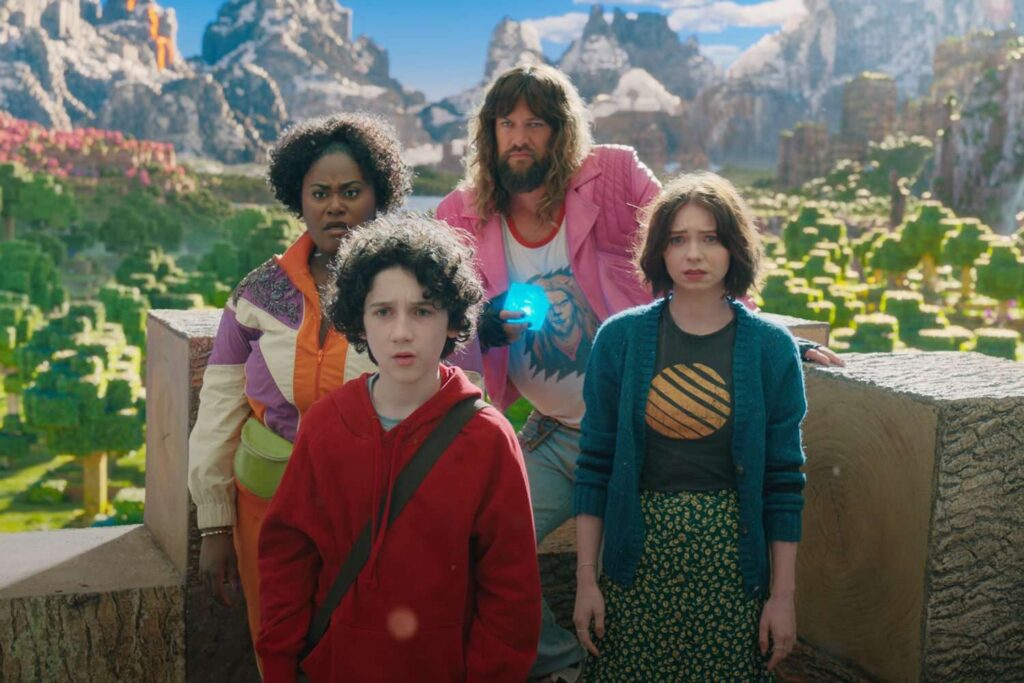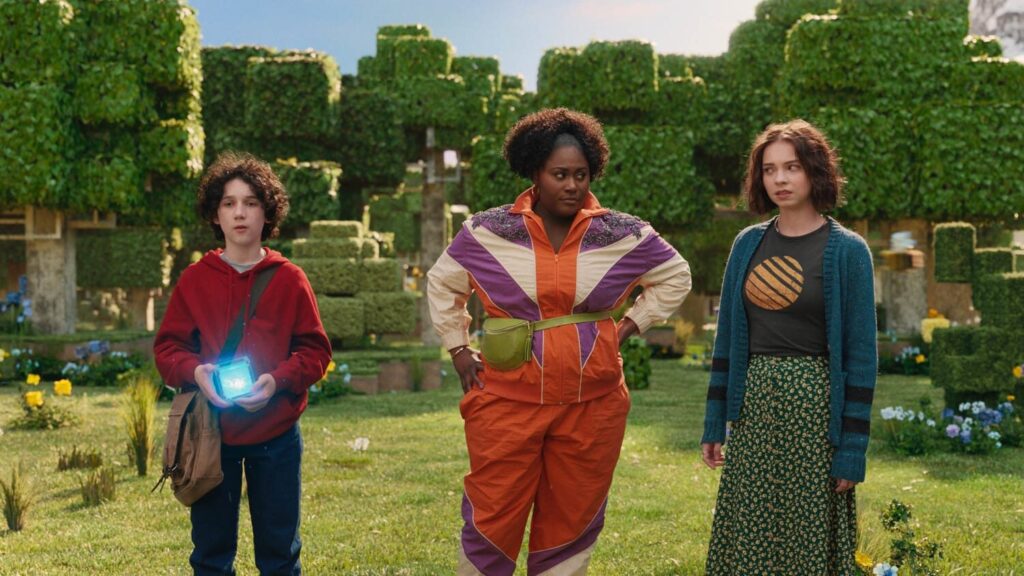I’m not expecting a kids’ film to be a feminist manifesto (especially not A Minecraft Movie), but is it too much to ask that in a family film where the boys get to quest and mess up, the girls aren’t stuck cleaning up after them?
In a decade where cinema has swung from the candy-coloured satire of Barbie to the delicious chaos of Wonka, A Minecraft Movie was set to be a breath of fresh, blocky air. A family-friendly triumph built from one of the most inclusive, boundless games ever created. Raking in over $700 million globally, the film certainly stacked its commercial credentials high. But somewhere between the end credits and the theatre popcorn trail, a question began to hum: why does this feel so… disappointedly familiar?
It’s easy – comforting, even – to dismiss gender critique in a children’s film as a bridge too far. “It’s Minecraft, not A Room of One’s Own,” stated one five-star Letterboxd reviewer. And yes, on its pixelated surface, it’s simply a family film. But when did we decide that children’s stories mattered less? Children’s films don’t just entertain. They build scaffolding for the values that young minds cling to long before they can name them.

A Minecraft Movie (2025) is a classic kids adventure romp that follows four unlikely heroes (Garrett, siblings Henry and Natalie, and real estate agent Dawn) who are transported from the real world into the blocky Overworld of Minecraft. Guided by former doorknob salesman Steve, the group embark on a quest to stop the evil Piglin ruler Malgosha from using the Orb of Dominance to conquer both dimensions.
So, what happens when a story set in a world of limitless creativity still gets trapped in the most ancient, looming gender roles? By dividing the adventures of A Minecraft Movie’s four unlucky heroes by gender, the film submits to outdated stereotypes for the sake of simplistic storytelling. A game once praised for its progress becomes a cultural artefact that, whether it means to or not, quietly helps stack the very walls that many have spent lifetimes trying to knock down.
The theory behind childish gender barriers and adult bias
Gaming has long been labelled as a distinctly male activity. Despite efforts to dig below this shallow understanding, the world of video games (especially those based on building, battling, and exploring) still largely fails to excavate below this first layer of male-centred marketing. Minecraft once stood apart. A rare sanctuary where boys, girls, and everyone beyond could simply be, unencumbered.
Enter the cinematic adaptation: a wooden shovel that seemed to fall apart before it could even break ground.

Psychologist Sandra Bem’s Gender Schema Theory reminds us that children learn how to “be” by absorbing cultural signals. These signals build mental blueprints that whisper: this is what boys do, this is what girls do. Sociologist Raewyn Connell sharpens this further with her theory of hegemonic masculinity: a hierarchy where traits like risk-taking and rebellion are crowned both masculine and superior.
Within A Minecraft Movie, this hierarchy plays out with weary predictability. The male protagonist leaps heedlessly into adventure, bumbling and growing through his mistakes. The central female character, Natalie, is relegated to the role of nagging moral compass. Less a heroine, more a portable conscience. He acts; she warns. He changes; she endures. While Steve, Henry and Garrett face dangers and hero trials, Natalie and Dawn’s biggest contribution is designing a safer home, once again forcing female creativity into the domestic space.
Even in a universe made of limitless potential, gender roles fall neatly into place. To misquote the renowned poem from Minecraft’s end credits, “And the universe said, there is nothing that is untouched by gender bias”.
“Just the sister”: An outcry of underwhelmed fans
“I came out of the Minecraft movie and my boyfriend said, ‘the girl characters were so unnecessary, if you took them out it wouldn’t have made a difference,’” shared TikTok user @lanaisleaving_. Another viral video by @bunny.bee.cosplays, amassing over 4.2 million views, hit the same note: “younger me would be so disappointed knowing the only thing the female protagonists did in the Minecraft movie was build a house.”
This wasn’t a niche complaint. It rang across reviews, discussions, and fan groups. As Screen Anarchy put it: “A film about one of the most creatively limitless games of all time should reflect that freedom. Instead, we get another story where the boy breaks the rules, the girl warns him not to, and they have to fix his mistake together.”
Natalie’s character is achingly familiar. We’ve met her countless times before: the ever-practical Hermione, the anxious Velma, the sensible older sister who tidies the wreckage boys leave behind. She doesn’t lead. She contains. And the more we see her, the more normalised that role becomes for girls watching. Non-male videogame fans are once again reminded that their role is to build comfort at home instead of leaving it – a reminder that will undoubtedly linger well beyond the film’s end credits.
Not everyone agrees
Of course, not everyone sees an issue. Some dismiss the criticism with a shrug: “It’s a Minecraft movie…… What could you have POSSIBLY expected from a movie about a game with no story, no characters, no nothing?”. Grinning children in creeper hoodies filled timelines and feeds, blissfully unaware of the debate swirling around the film.
And they’re right… in a way.
No film must carry the weight of feminist revolution. But no film exists in a cultural vacuum either. As Bem warns us, neutrality is a myth. Every frame tells a story about how the world should be. Every hero, every sidekick, every moment of triumph or hesitation carves another groove into the way children see themselves and each other. The tragedy isn’t that Minecraft needed to be a feminist manifesto. It’s that it could have been something freer, something truer to the spirit of the game it sprang from. A place where anyone could pick up a pickaxe or a sword or a dream, and shape the world.
Connell reminds us that cultural biases rarely scream. They whisper. They communicate through who gets the hero’s journey and who gets told to wait patiently behind. Critiquing children’s films isn’t about robbing them of joy. It’s about asking: what foundations are we laying, brick by brick, laugh by laugh, hero by hero?
Minecraft taught us that anyone can build anything. The movie taught us that Hollywood still isn’t ready to let girls believe it. Until that changes, films like A Minecraft Movie will continue to supply the quiet building blocks of bias, one pixel at a time.












